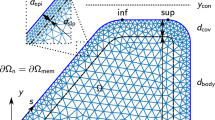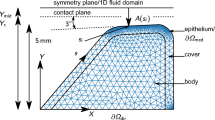Abstract
The mechanics of vocal fold contact during phonation is known to play a crucial role in both normal and pathological speech production, though the underlying physics is not well understood. Herein, a viscoelastic model of the stresses during vocal fold contact is developed. This model assumes the cover to be a poroelastic structure wherein interstitial fluid translocates in response to mechanical squeezing. The maximum interstitial fluid pressure is found to generally increase with decreasing viscous dissipation and/or decreasing tissue elasticity. A global minimum in the total contact stress, comprising interstitial fluid pressure and elastic stress in the tissue, is observed over the studied dimensionless parameter range. Interestingly, physiologically reasonable estimates for the governing parameters fall within this global minimum region. The model is validated against prior experimental and computational work, wherein the predicted contact stress magnitude and impact duration agree well with published results. Lastly, observations of the potential relationship between vocal fold hydration and increased risk of tissue damage are discussed based upon model predictions of stress as functions of cover layer thickness and viscosity.









Similar content being viewed by others
Notes
We note that the pressure distribution at \(t=0\) is also parabolic, which is a consequence of neglecting the surface dynamics at the onset of contact.
References
Alipour F, Scherer RC (2000) Dynamic glottal pressures in an excised hemilarynx model. J Voice 14:443–454
Benninger MS, Alessi D, Archer S, Bastian R, Ford C, Koufman J, Sataloff RT, Spiegel JR, Woo P (1996) Vocal fold scarring: current concepts and management. Otolaryngol Head Neck Surg 115:474–482
Bhattacharya P, Siegmund T (2012) A computational study of systemic hydration in vocal fold collision. Comput Methods Biomech Biomed Eng 17:1835–1852
Bhattacharya P, Siegmund T (2015) The role of glottal surface adhesion on vocal folds biomechanics. Biomech Model Mechanobiol 14:283–295
Chan RW, Tayama N (2002) Biomechanical effects of hydration in vocal fold tissues. Ann Otolaryngol Head Neck Surg 126:528–537
Chan RW, Tayama N (2006) Biomechanical effects of hydration in vocal fold tissues. Otolaryngol Head Neck Surg 126:528–537
Chan RW, Titze IR (2000) Viscoelastic shear properties of human vocal fold mucosa: theoretical characterization based on constituitive modeling. J Acoust Soc Am 107:565–580
Chhetri DK, Zhang Z, Neubauer J (2011) Measurement of young’s modulus of vocal folds by indentation. J Voice 25:1–7
Döllinger M, Berry DA, Berke GS (2005) Medial surface dynamics of an in vivo canine vocal fold during phonation. J Acoust Soc Am 117:3174–3183
Erath BD, Zañartu M, Stewart KC, Plesniak MW, Sommer DE, Peterson SD (2013) A review of lumped-element models of voiced speech. Speech Commun 55:667–690
Fisher K, Ligon J, Sobeck J, Roxe D (2001) Phonatory effects of body fluid removal. J Speech Lang Hear Res 44:354–367
Gray S, Titze I (1988) Histologic investigation of hyperphonated canine vocal cords. Ann Otol Rhinol Laryngol 97:381–388
Gray SD, Titze IR, Chan R, Hammond TH (1999) Vocal fold proteoglycans and their influence on biomechanics. Laryngoscope 109:845–854
Gunter H (2003) A mechanical model of vocal-fold collision with high spatial and temporal resolution. J Acoust Soc Am 113:994–1000
Gunter H (2004) Modeling mechanical stresses as a factor in the etiology of benign vocal fold lesions. J Biomech 37:1119–1124
Hess MM, Verdolini K, Bierhals W, Mansmann U, Gross M (1998) Endolaryngeal contact pressures. J Voice 12:50–67
Hillman RE, Holmberg EB, Perkell JS, Walsh M, Vaughan C (1989) Objective assessment of vocal hyperfunction: an experimental framework and initial results. J Speech Lang Hear Res 32:373–392
Hirano M (1977) Structure and vibratory behavior of the vocal folds. In: Sawashima M, Cooper FS (eds) Dynamics aspects of speech production. University of Tokyo, Tokyo, pp 13–27
Hirano M, Kurita S, Matsuo K, Nagata K (1980) Laryngeal tissure reaction to stress. In: Lawrence V (ed) Transcripts of the ninth symposium on care of the professional voice, part, 2nd edn. The Voice Foundation, New York, pp 10–20
Hirano M, Kurita S, Makashima T (1981) The structure of the vocal folds. In: Stevens K, Hirano M (eds) Vocal fold physiology. University of Tokyo Press, Tokyo, pp 33–41
Horacek J, Sidlof P, Svec JG (2005) Numerical simulation of self-oscillations of human vocal folds with Hertz model of impact forces. J Fluids Struct 20:853–869
Horacek J, Laukkanen AM, Sidlof P, Murphy P, Svec JG (2009) Comparison of acceleration and impact stress as possible loading factors in phonation: a computer modeling study. Folia Phoniatr Logop 61:137–145
Ishizaka K, Flanagan JL (1972) Synthesis of voice sounds from a two-mass model of the vocal cords. Bell Syst Tech J 51:1233–1268
Jiang JJ, Titze IR (1994) Measurement of vocal fold intraglottal pressure and impact stress. J Voice 8:132–144
Jiang JJ, Diaz CE, Hanson DG (1998) Finite element modeling of vocal fold vibration in normal phonation and hyperfunctional dysphonia: implications for the pathogenesis of vocal nodules. Ann Otol Rhinol Laryngol 107:603–610
Kojima T, VanDeusen M, Jerome WG, Garrett CG, Sivasankar MP, Novalesk CK, Rousseau B (2014) Quantification of acute vocal fold epithelial surface damage with increasing time and magnitude doses of vibration exposure. Plos One 9(e91):695
Lin DC, Shreiber DI, Dimitriadis EK, Horkay F (2009) Spherical indentation of soft matter beyond the Hertzian regime: numerical and experimental validation of hyperelastic models. Biomech Model Mechanobiol 8:345–358
Mak AK (1986) The apparent viscoelastic behavior of articular cartilate - the contributions from intrinsic matrix viscoelasticity and interstitial fluid flows. J Biomech Eng 108:123–130
Mehta DD, Zañartu M, Feng SW, Cheyne HA, Hillman RE (2012) Mobile voice health monitoring using a wearable acceleraometer sensor and a smartphone platform. IEEE Trans Biomed Eng 59:3090–3096
Mehta DD, Van Starn JH, Zañartu M, Ghassemi M, Guttag VM, Espinosa JP, Cortés JP, Cheyne HA, Hillman RE (2015) Using ambulatory voice monitoring to investigate common voice disorders: research update. Front Bioeng Biotechnol 3:1–14
Mittal R, Erath BD, Plesniak MW (2013) Fluid-dynamics of human phonation and speech. Ann Rev Fluid Mech 45:436–467
Mow VC, Kuei SC, Lai WM, Armstrong CG (1993) Biomechanics of diarthroidal joints: a review of twenty years of progress. J Biomech Eng 115:460–467
Oomens CWJ, Van Campen DH, Grootenboer HJ (1987) A mixture approach to the mechanics of skin. J Biomech 20:877–885
Ori Y, Sabo R, Binder Y, Weinstein T, Korzets A, Ori G, Chagnac A (2006) Effect of hemodialysis on the thickness of vocal folds: a possible explanation for postdialysis hoarseness. Nephron Clin Pract 103:144–148
Panton RL (1996) Incompressible flow. Wiley, New York
Perlman AL (1985) A technique for measuring the elastic propagation of vocal fold tissue. Ph.D. thesis, The University of Iowa, Iowa City, IA
Rosen C, Lombard L, Murry T (2000) Acoustic, aerodynamic, and videostroboscopic features of bilateral vocal fold lesions. Ann Otol Rhinol Laryngol 109:823–828
Scherer RC, Shinwari D, DeWitt KJ, Zhang C, Kucinschi BR, Afjeh AA (2001) Intraglottal pressure profiles for a symmetric and oblique glottis with a divergence angle of 10 degrees. J Acoust Soc Am 109:1616–1630
Sivasankar M, Leydon C (2010) The role of hydration in vocal fold physiology. Curr Opin Otolaryngol Head Neck Surg 18:171–175
Soltz MA, Ateshian GA (1998) Experimental verification and theoretical prediction of cartilage interstitial fluid pressurization at an impermeable contact interface in confined compression. J Biomech 31:927–934
Spencer M, Siegmung T, Mongeau L (2008) Determination of superior surface strains and stresses, and vocal fold contact pressure in a synthetic larynx model using digital image correlation. J Acoust Soc Am 123:1089–1103
Story BH, Titze IR (1995) Voice simulation with a body-cover model of the vocal folds. J Acoust Soc Am 97:1249–1260
Sun DD, Guo XE, Likhitpanichkul M, Lai WM, Mow VC (2004) The influence of the fixed negative charges on mechanical and electrical behaviors of articular cartilages under unconfined compression. J Bomech Eng 126:6–16
Tanner K, Roy N, Merrill R, Elstad M (2007) The effects of three nebulized osmotic agents in the dry larynx. J Speech Lang Hear Res 50:635–646
Tao C, Jiang JJ (2007) Mechanical stress during phonation in a self-oscillating finite-element vocal fold model. J Biomech 40:2191–2198
Tao C, Jiang JJ, Zhang Y (2009) A fluid-saturated poroelastic model of the vocal folds with hydrated tissue. J Biomech 42:774–780
Titze IR (1988) The physics of small-amplitude oscillation of the vocal folds. J Acoust Soc Am 83:1536–1552
Titze IR (1994a) Mechanical stress in phonation. J Voice 8:99–105
Titze IR (1994b) Principles of voice production. Prentice Hall, Englewood Cliffs
Titze IR, Story BH (2002) Rules for controlling low-dimensional vocal fold models with muscle activation. J Acoust Soc Am 112(3):1064–1076
Tsuyoshi K, Van Deusen M, Jerome WG, Garrett CG, Sivasankar MP, Novaleski CK, Rousseau B (2014) Quanitfication of acute vocal fold epithelial surface damage with increasing time and magnitude doses of vibration exposure. PLOS One 9(e91):615
Türk L (1886) Klinik der Krankheiten des Kehlkopfes und der luftröhre (Clinical Diseases of the Trachea and Larynx). Maximillian Bresgen, Wien
Verdolini K (1988) Practice good vocal health and prevent those voice disorders. Chorist Guild Lett 2:40–44
Verdolini K, Sandage M, Titze IR (1994) Effects of hydration treatments on laryngeal nodules and polyps and related voice measures. J Voice 8:30–47
Verdolini K, Hess MM, Titze IR, Bierhals W, Gross M (1999) Investigation of vocal fold impact stress in human subjects. J Voice 13:184–202
Zañartu M, Mongeau L, WG R, (2007) Influence of acoustic loading on an effective single-mass model of the vocal folds. J Acoust Soc Am 121:1119–1129
Zañartu M, Galindo GE, Erath BD, Peterson SD, Wodicka GR, Hillman RE (2014) Modeling the effects of a posterior glottal opening on vocal fold dynamics with implications for vocal hyperfunction. J Acoust Soc Am 136:3262–3271
Zhang Z (2009) Characteristics of phonation onset in a two-layer vocal fold model. J Acoust Soc Am 125(2):1091–1102
Zhang Y, Czerwonka L, Tao C, Jiang JJ (2008) A biphasic theory for the viscoelastic behaviors of vocal fold lamina propria in stress relaxation. J Acoust Soc Am 123:1627–1636
Acknowledgements
This work was funded in part by the Ontario Ministry of Research and Innovation through the Early Researcher Award program Grant ER13-09-269, the Natural Sciences and Engineering Research Council through Grant 386282-2010, and the Chilean CONICYT through Grants FONDECYT 1151077 and BASAL FB0008.
Author information
Authors and Affiliations
Corresponding author
Rights and permissions
About this article
Cite this article
Erath, B.D., Zañartu, M. & Peterson, S.D. Modeling viscous dissipation during vocal fold contact: the influence of tissue viscosity and thickness with implications for hydration. Biomech Model Mechanobiol 16, 947–960 (2017). https://doi.org/10.1007/s10237-016-0863-5
Received:
Accepted:
Published:
Issue Date:
DOI: https://doi.org/10.1007/s10237-016-0863-5




